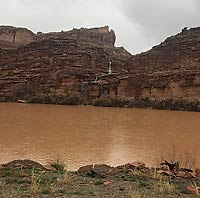Science HAPPENINGS May 2019 |
|
| Go ahead. Peak! | |
 Moab and much of the Upper Colorado River Basin enjoyed a wetter than average winter and spring, with the La Sal Mountains receiving over 150% of its normal snowpack. As the gleaming white mountains shine down on Moab valley, river runners and scientists alike eagerly await the rise in river levels that is sure to follow. What is less sure, though, is how much the river will rise and when. Maximum river flows, known as peak flows, can be notoriously difficult to predict. They depend not only on how much water is held in the snow on the mountains, but how quickly air temperatures rise. A mild, gently warming spring can lead to a longer season of higher water levels with a lower peak. Rapid warming can lead to rapid snowmelt and a much higher and steeper peak. Some of the highest peaks occur when rain falls on snow, accelerating its rush down the mountainsides. Moab and much of the Upper Colorado River Basin enjoyed a wetter than average winter and spring, with the La Sal Mountains receiving over 150% of its normal snowpack. As the gleaming white mountains shine down on Moab valley, river runners and scientists alike eagerly await the rise in river levels that is sure to follow. What is less sure, though, is how much the river will rise and when. Maximum river flows, known as peak flows, can be notoriously difficult to predict. They depend not only on how much water is held in the snow on the mountains, but how quickly air temperatures rise. A mild, gently warming spring can lead to a longer season of higher water levels with a lower peak. Rapid warming can lead to rapid snowmelt and a much higher and steeper peak. Some of the highest peaks occur when rain falls on snow, accelerating its rush down the mountainsides.As of this writing, the peak flow for the Colorado River at Cisco is predicted to be 33,000 cubic feet per second (cfs; a cubic foot is about 7.5 US gallons), which is very close to the 30-year average and would be the 3rd highest peak over the past 10 years. So if there’s more snow than normal, why is the peak flow only predicted to be average? Most of the difference comes from that unpredictable snowmelt timing. The highest peak flow on record, 69,500 cfs in 1984, occurred during a year when snow continued to fall into April and May, leading to rapid runoff in June and a huge peak. The 1984 peak followed a very wet 1983, when soils (which normally soak up water during the spring melt) were already wet and full. In contrast, 2019 is following an extremely dry year, and soils have the capacity to absorb a substantial amount of snowmelt before runoff begins. A slow, prolonged melt would help benefit our forests and desert, providing more water in the soil for plants to use as the growing season goes on. Big or little, sustained or rapid, this year’s river level peak will be welcome to everyone who lives and plays in southeastern Utah. |
